
Neue Pinakothek
Encyclopedia
The Neue Pinakothek is an art museum
in Munich
, Germany
. Its focus is European Art
of the 18th and 19th century and is one of the most important museums of art of the nineteenth century in the world. Together with the Alte Pinakothek
and the Pinakothek der Moderne
it is part of Munich's "Kunstareal
" (the "art area").
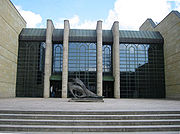
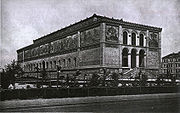
of Bavaria
in 1853. The original building constructed by Friedrich von Gärtner
and August von Voit
was destroyed during World War II
. The ruin of the Neue Pinakothek was demolished in 1949. Designed by architect Alexander Freiherr von Branca the new postmodern
building opened in 1981.
s in the Alte Pinakothek was fixed with the period shortly before the turn of the 19th century, which has become a prototype for many galleries.
The delimitation to the modern
painters displayed in the Pinakothek der Moderne was later fixed by taking the restart of Henri Matisse
and the Expressionists
into account (ca. 1900).
Consequentially a painting of Matisse acquired by the "Tschudi Contribution" is displayed in the Pinakothek der Moderne.
The so-called Tschudi Contribution in 1905/1914 led to an extraordinary collection of masterpieces of Impressionism
and Post-Impressionism
. Hugo von Tschudi
, general director of the State Collections acquired 44 paintings, nine sculptures and 22 drawings, mostly from new French artists. But since public funds could not be used to purchase these works, Tschudi’s associates came up with the money from private contributions after his death in 1911.
In 1915 the Neue Pinakothek became the property of the Bavarian state. A self-portrait of Vincent van Gogh was confiscated in 1938 by the Nazi regime as degenerate art
and sold one year later.
to art nouveau
. About 400 paintings and 50 sculptures of these are exhibited in the New Pinakothek.
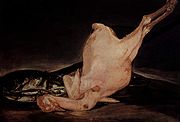
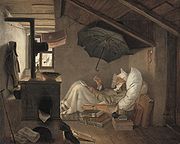
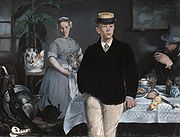
Art gallery
An art gallery or art museum is a building or space for the exhibition of art, usually visual art.Museums can be public or private, but what distinguishes a museum is the ownership of a collection...
in Munich
Munich
Munich The city's motto is "" . Before 2006, it was "Weltstadt mit Herz" . Its native name, , is derived from the Old High German Munichen, meaning "by the monks' place". The city's name derives from the monks of the Benedictine order who founded the city; hence the monk depicted on the city's coat...
, Germany
Germany
Germany , officially the Federal Republic of Germany , is a federal parliamentary republic in Europe. The country consists of 16 states while the capital and largest city is Berlin. Germany covers an area of 357,021 km2 and has a largely temperate seasonal climate...
. Its focus is European Art
Western art history
Western art is the art of the North American and European countries, and art created in the forms accepted by those countries.Written histories of Western art often begin with the art of the Ancient Middle East, Ancient Egypt and the Ancient Aegean civilisations, dating from the 3rd millennium BC...
of the 18th and 19th century and is one of the most important museums of art of the nineteenth century in the world. Together with the Alte Pinakothek
Alte Pinakothek
The Alte Pinakothek is an art museum situated in the Kunstareal in Munich, Germany. It is one of the oldest galleries in the world and houses one of the most famous collections of Old Master paintings...
and the Pinakothek der Moderne
Pinakothek der Moderne
The Pinakothek der Moderne is a modern art museum, situated in the city centre of Munich, Germany. Together with its two predecessors Alte Pinakothek and Neue Pinakothek The Pinakothek der Moderne (= "(Art) Gallery of the Modern"; from Greek: "pinax" = "board", "tablet") is a modern art museum,...
it is part of Munich's "Kunstareal
Kunstareal
The Kunstareal is a museum quarter in the city centre of Munich, Germany.It consists of the three "Pinakotheken" galleries , the Glyptothek, the Staatliche Antikensammlung , the Lenbachhaus, the Museum Brandhorst and...
" (the "art area").


The building
The museum was founded by the former King Ludwig ILudwig I of Bavaria
Ludwig I was a German king of Bavaria from 1825 until the 1848 revolutions in the German states.-Crown prince:...
of Bavaria
Bavaria
Bavaria, formally the Free State of Bavaria is a state of Germany, located in the southeast of Germany. With an area of , it is the largest state by area, forming almost 20% of the total land area of Germany...
in 1853. The original building constructed by Friedrich von Gärtner
Friedrich von Gärtner
Friedrich von Gärtner was a German architect.Gärtner and Leo von Klenze are the most well known architects of Bavaria during the reign of Ludwig I. His architecture was generally in the Romanesque style and much to the king's taste...
and August von Voit
August von Voit
Richard Jakob August von Voit was a German architect.Voit designed the city hall of Annweiler am Trifels , the Fruchthalle in Kaiserslautern , the Neue Pinakothek and the Glaspalast for the Erste Allgemeine Deutsche...
was destroyed during World War II
World War II
World War II, or the Second World War , was a global conflict lasting from 1939 to 1945, involving most of the world's nations—including all of the great powers—eventually forming two opposing military alliances: the Allies and the Axis...
. The ruin of the Neue Pinakothek was demolished in 1949. Designed by architect Alexander Freiherr von Branca the new postmodern
Postmodernism
Postmodernism is a philosophical movement evolved in reaction to modernism, the tendency in contemporary culture to accept only objective truth and to be inherently suspicious towards a global cultural narrative or meta-narrative. Postmodernist thought is an intentional departure from the...
building opened in 1981.
History
Ludwig began to collect contemporary art already as crown prince in 1809 and his collection has been steadily enlarged. When the museum was founded the separtation to the old masterOld Master
"Old Master" is a term for a European painter of skill who worked before about 1800, or a painting by such an artist. An "old master print" is an original print made by an artist in the same period...
s in the Alte Pinakothek was fixed with the period shortly before the turn of the 19th century, which has become a prototype for many galleries.
The delimitation to the modern
Modernity
Modernity typically refers to a post-traditional, post-medieval historical period, one marked by the move from feudalism toward capitalism, industrialization, secularization, rationalization, the nation-state and its constituent institutions and forms of surveillance...
painters displayed in the Pinakothek der Moderne was later fixed by taking the restart of Henri Matisse
Henri Matisse
Henri Matisse was a French artist, known for his use of colour and his fluid and original draughtsmanship. He was a draughtsman, printmaker, and sculptor, but is known primarily as a painter...
and the Expressionists
Expressionism
Expressionism was a modernist movement, initially in poetry and painting, originating in Germany at the beginning of the 20th century. Its typical trait is to present the world solely from a subjective perspective, distorting it radically for emotional effect in order to evoke moods or ideas...
into account (ca. 1900).
Consequentially a painting of Matisse acquired by the "Tschudi Contribution" is displayed in the Pinakothek der Moderne.
The so-called Tschudi Contribution in 1905/1914 led to an extraordinary collection of masterpieces of Impressionism
Impressionism
Impressionism was a 19th-century art movement that originated with a group of Paris-based artists whose independent exhibitions brought them to prominence during the 1870s and 1880s...
and Post-Impressionism
Post-Impressionism
Post-Impressionism is the term coined by the British artist and art critic Roger Fry in 1910 to describe the development of French art since Manet. Fry used the term when he organized the 1910 exhibition Manet and Post-Impressionism...
. Hugo von Tschudi
Hugo von Tschudi
Hugo von Tschudi was an art historian and museum curator, notable for being a collector of important Impressionist works. Tschudi was born in Austria and became a naturalised Swiss citizen....
, general director of the State Collections acquired 44 paintings, nine sculptures and 22 drawings, mostly from new French artists. But since public funds could not be used to purchase these works, Tschudi’s associates came up with the money from private contributions after his death in 1911.
In 1915 the Neue Pinakothek became the property of the Bavarian state. A self-portrait of Vincent van Gogh was confiscated in 1938 by the Nazi regime as degenerate art
Degenerate art
Degenerate art is the English translation of the German entartete Kunst, a term adopted by the Nazi regime in Germany to describe virtually all modern art. Such art was banned on the grounds that it was un-German or Jewish Bolshevist in nature, and those identified as degenerate artists were...
and sold one year later.
Collection
The museum is under supervision of the Bavarian State Painting Collections which houses an expanded collection of more than 3.000 European paintings from classicismClassicism
Classicism, in the arts, refers generally to a high regard for classical antiquity, as setting standards for taste which the classicists seek to emulate. The art of classicism typically seeks to be formal and restrained: of the Discobolus Sir Kenneth Clark observed, "if we object to his restraint...
to art nouveau
Art Nouveau
Art Nouveau is an international philosophy and style of art, architecture and applied art—especially the decorative arts—that were most popular during 1890–1910. The name "Art Nouveau" is French for "new art"...
. About 400 paintings and 50 sculptures of these are exhibited in the New Pinakothek.

- International paintings of the second half of 18th century:
- Among others the gallery exhibits works of Francisco de Goya (Plucked Turkey) (Don José Queraltó as a Spanish Army doctor), Jacques-Louis DavidJacques-Louis DavidJacques-Louis David was an influential French painter in the Neoclassical style, considered to be the preeminent painter of the era...
(Anne-Marie-Louise Thélusson, Comtesse de Sorcy), Johann Friedrich August TischbeinJohann Friedrich August TischbeinJohann Friedrich August Tischbein was a German painter. He was the most notable painter from the second generation of the Tischbein family of portrait painters and was known as the Leipziger Tischbein...
(Nicolas Châtelain in the garden) and Anton GraffAnton GraffAnton Graff was an eminent Swiss portrait artist. Among his famous subjects were Friedrich Schiller, Christoph Willibald Gluck, Heinrich von Kleist, Frederick the Great, Johann Gottfried Herder and Christian Felix Weisse...
(Heinrich XIII, Graf Reuß).
- English paintings of 18th and early 19th century:
- It's one of the largest collections outside the United Kingdom with masterpieces of Thomas GainsboroughThomas GainsboroughThomas Gainsborough was an English portrait and landscape painter.-Suffolk:Thomas Gainsborough was born in Sudbury, Suffolk. He was the youngest son of John Gainsborough, a weaver and maker of woolen goods. At the age of thirteen he impressed his father with his penciling skills so that he let...
(Mrs. Thomas Hibbert) (Landscape with Shepherd and Flock), William HogarthWilliam HogarthWilliam Hogarth was an English painter, printmaker, pictorial satirist, social critic and editorial cartoonist who has been credited with pioneering western sequential art. His work ranged from realistic portraiture to comic strip-like series of pictures called "modern moral subjects"...
(Richard Mounteney), John ConstableJohn ConstableJohn Constable was an English Romantic painter. Born in Suffolk, he is known principally for his landscape paintings of Dedham Vale, the area surrounding his home—now known as "Constable Country"—which he invested with an intensity of affection...
(View of Dedham Vale from East Bergholt), Joshua ReynoldsJoshua ReynoldsSir Joshua Reynolds RA FRS FRSA was an influential 18th-century English painter, specialising in portraits and promoting the "Grand Style" in painting which depended on idealization of the imperfect. He was one of the founders and first President of the Royal Academy...
(Captain Philemon Pownall), David WilkieDavid Wilkie (artist)Sir David Wilkie was a Scottish painter.- Early life :Wilkie was the son of the parish minister of Cults in Fife. He developed a love for art at an early age. In 1799, after he had attended school at Pitlessie, Kettle and Cupar, his father reluctantly agreed to his becoming a painter...
(Reading the Will), Thomas LawrenceThomas Lawrence (painter)Sir Thomas Lawrence RA FRS was a leading English portrait painter and president of the Royal Academy.Lawrence was a child prodigy. He was born in Bristol and began drawing in Devizes, where his father was an innkeeper. At the age of ten, having moved to Bath, he was supporting his family with his...
(The Two Sons of the 1st Earl of Talbot), George RomneyGeorge Romney (painter)George Romney was an English portrait painter. He was the most fashionable artist of his day, painting many leading society figures - including his artistic muse, Emma Hamilton, mistress of Lord Nelson....
(Catherine Clements), Richard WilsonRichard Wilson (painter)Richard Wilson was a Welsh landscape painter, and one of the founder members of the Royal Academy in 1768. Wilson has been described as '...the most distinguished painter Wales has ever produced and the first to appreciate the aesthetic possibilities of his country.' He is considered to be the...
(View of Syon House Across the Thames near Richmond Gardens), Henry RaeburnHenry RaeburnSir Henry Raeburn was a Scottish portrait painter, the first significant Scottish portraitist since the Act of Union 1707 to remain based in Scotland.-Biography:...
(Mrs. J. Campbell of Kilberry), George StubbsGeorge StubbsGeorge Stubbs was an English painter, best known for his paintings of horses.-Biography:Stubbs was born in Liverpool, the son of a currier and leather merchant. Information on his life up to age thirty-five is sparse, relying almost entirely on notes made by fellow artist Ozias Humphry towards the...
(The pointer) and J. M. W. TurnerJ. M. W. TurnerJoseph Mallord William Turner RA was an English Romantic landscape painter, watercolourist and printmaker. Turner was considered a controversial figure in his day, but is now regarded as the artist who elevated landscape painting to an eminence rivalling history painting...
(Ostende).
- German artists of Classicism in Rome
- like Friedrich Overbeck (Italia and Germania), Friedrich Wilhelm von Schadow (The Holy Family beneath the Portico), Heinrich Maria von HessHeinrich Maria von HessHeinrich Maria von Hess was a German painter, a member of the Nazarene movement.-Biography:He was born at Düsseldorf and brought up to the profession of art by his father, the engraver Karl Ernst Christoph Hess...
(Marchesa Marianna Florenzi), Peter von HessPeter von HessPeter Heinrich Lambert von Hess was a German painter, known for historic paintings, especially of the Napoleonic Wars and the Greek War of Independence.-Life:...
(The Entry of King Othon of Greece into Nauplia) and Peter von CorneliusPeter von CorneliusPeter von Cornelius was a German painter.Cornelius was born in Düsseldorf.His father, who was inspector of the Düsseldorf gallery, died in 1799, and the young Cornelius was stimulated to extraordinary exertions...
(The three Marys at the Tomb).
- German RomanticismGerman RomanticismFor the general context, see Romanticism.In the philosophy, art, and culture of German-speaking countries, German Romanticism was the dominant movement of the late 18th and early 19th centuries. German Romanticism developed relatively late compared to its English counterpart, coinciding in its...
- with paintings of Caspar David FriedrichCaspar David FriedrichCaspar David Friedrich was a 19th-century German Romantic landscape painter, generally considered the most important German artist of his generation. He is best known for his mid-period allegorical landscapes which typically feature contemplative figures silhouetted against night skies, morning...
(Garden Bower), Karl Friedrich SchinkelKarl Friedrich SchinkelKarl Friedrich Schinkel was a Prussian architect, city planner, and painter who also designed furniture and stage sets. Schinkel was one of the most prominent architects of Germany and designed both neoclassical and neogothic buildings.-Biography:Schinkel was born in Neuruppin, Margraviate of...
(Cathedral Towering over a Town) und Carl BlechenCarl BlechenCarl Blechen , sometimes given as Karl Blechen, was a German painter, specializing in fantastic landscapes, sometimes with demons and grotesque figures....
(Building of the Devil's Bridge) and others.

- Biedermeier
- represented by Franz Xaver Winterhalter (Graf Jenison-Walworth), Carl SpitzwegCarl SpitzwegCarl Spitzweg was a German romanticist painter and poet. He is considered to be one of the most important artists of the Biedermeier era....
(The Poor Poet) , Moritz von SchwindMoritz von Schwindthumb|Moritz von Schwind, c. 1860Moritz von Schwind was an Austrian painter, born in Vienna.Moritz von Schwind received rudimentary training and spent a happy and carefree youth in Vienna. Among his companions was the composer Schubert, some of whose songs he illustrated...
(A Symphony) and Ferdinand Georg WaldmüllerFerdinand Georg WaldmüllerFerdinand Georg Waldmüller was an Austrian painter and writer.He briefly attended the Academy of Fine Arts Vienna, but later had to finance his life by painting portraits. In 1811 he worked as a teacher of arts for the children of Count Gyulay in Croatia...
(Young Peasant Woman with Three Children at the Window).
- French RealismRealism (arts)Realism in the visual arts and literature refers to the general attempt to depict subjects "in accordance with secular, empirical rules", as they are considered to exist in third person objective reality, without embellishment or interpretation...
and French RomanticismRomanticismRomanticism was an artistic, literary and intellectual movement that originated in the second half of the 18th century in Europe, and gained strength in reaction to the Industrial Revolution...
- with Eugène DelacroixEugène DelacroixFerdinand Victor Eugène Delacroix was a French Romantic artist regarded from the outset of his career as the leader of the French Romantic school...
(Clorinda Rescues Olindo and Sophronia), Théodore GéricaultThéodore GéricaultJean-Louis André Théodore Géricault was a profoundly influential French artist, painter and lithographer, known for The Raft of the Medusa and other paintings...
(Artillery Train Passing a Ravine), Gustave CourbetGustave CourbetJean Désiré Gustave Courbet was a French painter who led the Realist movement in 19th-century French painting. The Realist movement bridged the Romantic movement , with the Barbizon School and the Impressionists...
(Landscape near Maizières), Jean-François MilletJean-François MilletJean-François Millet was a French painter and one of the founders of the Barbizon school in rural France...
(Farmer Inserting a Graft on a Tree), Honoré DaumierHonoré DaumierHonoré Daumier was a French printmaker, caricaturist, painter, and sculptor, whose many works offer commentary on social and political life in France in the 19th century....
(The Drama) and others.
- Deutschrömer (or German-Romans)
- such as Hans von MaréesHans von MaréesHans von Marées was a German painter. He mainly painted country scenes in a realistic style.Von Marées was born in Elberfeld, Germany. At age 16, he was sent to the Berlin Academy. In 1857, he moved to Munich....
(Self-Portrait), Arnold BöcklinArnold BöcklinArnold Böcklin was a Swiss symbolist painter.-Life and art:He was born at Basel. His father, Christian Frederick Böcklin , was descended from an old family of Schaffhausen, and engaged in the silk trade. His mother, Ursula Lippe, was a native of the same city...
(Pan in the Reeds), Anselm FeuerbachAnselm FeuerbachAnselm Feuerbach was a German painter. He was the leading classicist painter of the German 19th-century school.-Biography:...
(Medea) and Hans ThomaHans ThomaHans Thoma was a German painter.-Biography:He was born in Bernau in the Black Forest, Germany. Having started life as a painter of clock-faces, he entered in 1859 the Karlsruhe academy, where he studied under Schirmer and Des Coudres...
(Landscape in the Taunus).
- History paintings
- with Wilhelm von KaulbachWilhelm von KaulbachWilhelm von Kaulbach was a German painter, noted mainly as a muralist, but also as a book illustrator. His murals decorate buildings in Munich.-Education:...
( King Ludwig I sourronded by artists), Karl Theodor von Piloty (Seni and Wallenstein), Franz von Defregger (Das letzte Aufgebot) and Hans Markart (Die Falknerin).
- German Realism
- like Wilhelm LeiblWilhelm LeiblWilhelm Maria Hubertus Leibl was a German realist painter of portraits and scenes of peasant life.Leibl was born in Cologne and in 1861 began his first training with Hermann Becker, a local painter. He entered the Munich Academy in 1864, subsequently studying with several artists including Carl...
(Portrait of Frau Gedon), Franz von LenbachFranz von LenbachFranz von Lenbach was a German painter of Realist style.-Biography:Lenbach was born at Schrobenhausen, in Bavaria. His father was a mason, and the boy was intended to follow his father's trade or be a builder. With this view he was sent to school at Landsberg, and then to the polytechnic at Augsburg...
(Aresing Village Street) and Adolph Menzel (Living-Room with the Artist's Sister).
- German Impressionists
- especially Max LiebermannMax LiebermannMax Liebermann was a German-Jewish painter and printmaker best known for his etching and lithography.-Biography:...
(Boys Bathing), Lovis CorinthLovis CorinthLovis Corinth was a German painter and printmaker whose mature work realized a synthesis of impressionism and expressionism....
(Eduard, Count von Keyserling) und Max SlevogtMax SlevogtMax Slevogt was a German Impressionist painter and illustrator, best known for his landscapes. He was, together with Lovis Corinth and Max Liebermann, one of the foremost representatives in Germany of the plein air style.-Biography:He was born in Landshut, Germany...
(The Day's Work Done).

- French Impressionists
- One of the world's leading collections with masterpieces of Pierre-Auguste RenoirPierre-Auguste RenoirPierre-Auguste Renoir was a French artist who was a leading painter in the development of the Impressionist style. As a celebrator of beauty, and especially feminine sensuality, it has been said that "Renoir is the final representative of a tradition which runs directly from Rubens to...
(Portrait of a Young Woman), Edouard ManetÉdouard ManetÉdouard Manet was a French painter. One of the first 19th-century artists to approach modern-life subjects, he was a pivotal figure in the transition from Realism to Impressionism....
(Lucheon in the Studio) (Monet Painting on His Studio Boat), Claude MonetClaude MonetClaude Monet was a founder of French impressionist painting, and the most consistent and prolific practitioner of the movement's philosophy of expressing one's perceptions before nature, especially as applied to plein-air landscape painting. . Retrieved 6 January 2007...
(The Bridge at Argenteuil), Paul CézannePaul CézannePaul Cézanne was a French artist and Post-Impressionist painter whose work laid the foundations of the transition from the 19th century conception of artistic endeavour to a new and radically different world of art in the 20th century. Cézanne can be said to form the bridge between late 19th...
(The Railway Cutting), Paul GauguinPaul GauguinEugène Henri Paul Gauguin was a leading French Post-Impressionist artist. He was an important figure in the Symbolist movement as a painter, sculptor, print-maker, ceramist, and writer...
(The Birth - Te tamari no atua), Edgar DegasEdgar DegasEdgar Degas[p] , born Hilaire-Germain-Edgar De Gas, was a French artist famous for his work in painting, sculpture, printmaking and drawing. He is regarded as one of the founders of Impressionism although he rejected the term, and preferred to be called a realist...
(Woman Ironing), Camille PissarroCamille PissarroCamille Pissarro was a French Impressionist and Neo-Impressionist painter born on the island of St Thomas . His importance resides in his contributions to both Impressionism and Post-Impressionism, as he was the only artist to exhibit in both forms...
(Street in Upper Norwood), Alfred SisleyAlfred SisleyAlfred Sisley was an Impressionist landscape painter who was born and spent most of his life, in France, but retained British citizenship. He was the most consistent of the Impressionists in his dedication to painting landscape en plein air...
(The Road to Hampton Court), Georges-Pierre Seurat and Vincent van GoghVincent van GoghVincent Willem van Gogh , and used Brabant dialect in his writing; it is therefore likely that he himself pronounced his name with a Brabant accent: , with a voiced V and palatalized G and gh. In France, where much of his work was produced, it is...
(Sunflowers) (The Weaver).
- Symbolism and Art Nouveau and early 20th century
- represented among others by Giovanni SegantiniGiovanni SegantiniGiovanni Segantini was an Italian painter known for his large pastoral landscapes of the Alps. He was one of the most famous artists in Europe in the late 19th century, and his paintings were collected by major museums. In later life he combined a Divisionist painting style with Symbolist images...
(L'aratura), Gustav KlimtGustav KlimtGustav Klimt was an Austrian Symbolist painter and one of the most prominent members of the Vienna Secession movement. His major works include paintings, murals, sketches, and other art objects...
(Margaret Stonborough-Wittgenstein), Paul SignacPaul SignacPaul Signac was a French neo-impressionist painter who, working with Georges Seurat, helped develop the pointillist style.-Biography:Paul Victor Jules Signac was born in Paris on 11 November 1863...
(S.Maria della Salute), Maurice DenisMaurice DenisMaurice Denis was a French painter and writer, and a member of the Symbolist and Les Nabis movements. His theories contributed to the foundations of cubism, fauvism, and abstract art.-Childhood and education:...
(Gaulish Goddess of Herds and Flocks), Henri de Toulouse-LautrecHenri de Toulouse-LautrecHenri Marie Raymond de Toulouse-Lautrec-Monfa or simply Henri de Toulouse-Lautrec was a French painter, printmaker, draughtsman, and illustrator, whose immersion in the colourful and theatrical life of fin de siècle Paris yielded an œuvre of exciting, elegant and provocative images of the modern...
(Le jeune Routy à Céleyran), James EnsorJames EnsorJames Sidney Edouard, Baron Ensor was a Flemish-Belgian painter and printmaker, an important influence on expressionism and surrealism who lived in Ostend for almost his entire life...
(Still Life in the Studio), Edouard VuillardÉdouard VuillardJean-Édouard Vuillard was a French painter and printmaker associated with the Nabis.-Early years and education:...
(Café Scene), Ferdinand HodlerFerdinand HodlerFerdinand Hodler was one of the best-known Swiss painters of the 19th century.-Life:Hodler was born in Berne, the eldest of six children. His father, Jean Hodler, made a meager living as a carpenter; his mother, Marguerite , was from a peasant family...
(Tired of Life), Franz von Stuck (The Sin), Edvard MunchEdvard MunchEdvard Munch was a Norwegian Symbolist painter, printmaker and an important forerunner of expressionist art. His best-known composition, The Scream, is part of a series The Frieze of Life, in which Munch explored the themes of love, fear, death, melancholia, and anxiety.- Childhood :Edvard Munch...
(Woman in Red Dress (Street in Aasgaardstrand)), Walter CraneWalter CraneWalter Crane was an English artist and book illustrator. He is considered to be the most prolific and influential children’s book creator of his generation and, along with Randolph Caldecott and Kate Greenaway, one of the strongest contributors to the child's nursery motif that the genre of...
(Neptun's horses), Thomas Austen Brown (Mademoiselle Plume rouge), Pierre BonnardPierre BonnardPierre Bonnard was a French painter and printmaker, as well as a founding member of Les Nabis.-Biography:...
(Lady at the Mirror) and Egon SchieleEgon SchieleEgon Schiele was an Austrian painter. A protégé of Gustav Klimt, Schiele was a major figurative painter of the early 20th century. His work is noted for its intensity, and the many self-portraits the artist produced...
(Agony).
- Sculptures
- Also sculptures of the 19th century are exhibited, for example works of Bertel ThorvaldsenBertel ThorvaldsenBertel Thorvaldsen was a Danish-Icelandic sculptor of international fame, who spent most of his life in Italy . Thorvaldsen was born in Copenhagen into a Danish/Icelandic family of humble means, and was accepted to the Royal Academy of Arts when he was eleven years old...
(Adonis), Antonio CanovaAntonio CanovaAntonio Canova was an Italian sculptor from the Republic of Venice who became famous for his marble sculptures that delicately rendered nude flesh...
(Paris), Rudolph SchadowRudolph SchadowRudolph Schadow was a German sculptor.Born in Rome, he had his father at Berlin for his first master....
(Woman Tying Her Sandal), Auguste RodinAuguste RodinFrançois-Auguste-René Rodin , known as Auguste Rodin , was a French sculptor. Although Rodin is generally considered the progenitor of modern sculpture, he did not set out to rebel against the past...
(Crouching Woman (La femme accroupie)), Max KlingerMax KlingerMax Klinger was a German Symbolist painter, sculptor, printmaker, and writer.Klinger was born in Leipzig and studied in Karlsruhe. An admirer of the etchings of Menzel and Goya, he shortly became a skilled and imaginative engraver in his own right. He began creating sculptures in the early 1880s...
(Elsa Asenijeff), Aristide MaillolAristide MaillolAristide Maillol or Aristides Maillol was a French Catalan sculptor and painter.-Biography:...
(La Flore), Pablo PicassoPablo PicassoPablo Diego José Francisco de Paula Juan Nepomuceno María de los Remedios Cipriano de la Santísima Trinidad Ruiz y Picasso known as Pablo Ruiz Picasso was a Spanish expatriate painter, sculptor, printmaker, ceramicist, and stage designer, one of the greatest and most influential artists of the...
(Le Fou) and others.
External links
- Official website (in English)
- website (in German)
- Article about the Neue Pinakothek
- Lionel GossmanLionel GossmanLionel Gossman is a Scottish-American scholar of French literature. He taught Romance Languages at Johns Hopkins University and Princeton University, and has written extensively on the history, theory and practice of historiography, and more recently, on aspects of German cultural...
. “Making of a Romantic Icon: The Religious Context of Friedrich Overbeck’s ‘Italia und Germania.’” American Philosophical Society, 2007. ISBN 0871699753. http://dianepub.wordpress.com/2010/06/30/lionel-gossman-making-of-a-romantic-icon-the-religious-context-of-friedrich-overbeck%E2%80%99s-italia-und-germaniaamerican-philosophical-society-transaction-97-5-isbn-0871699753/

